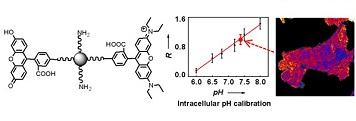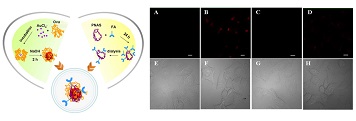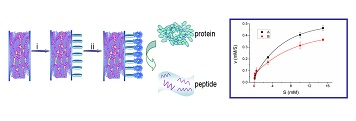|
| Insight on research |
|
 |
|
| Huimin Ma group has made important progress in the second near-infrared spectroscopic probe |
| Fluorophores in the second near-infrared window (NIR-II, 1000-1700 nm) have attracted extensive attention due to their better imaging quality and deeper tissue penetration than those in the first near-infrared window (NIR-I, 650?900 nm). Currently, NIR-II fluorophores are primarily based on inorganic nanomaterials, but their disputable toxicity hinders preclinical translation. In contrast, organic small molecular fluorophores have presented satisfactory safety profiles and have been used in ... |
|
|
 |
|
| New spectroscopic probe and its application to fluorescence imaging of hydroxyl radical |
| Development of new spectroscopic probes and specific imaging methods is of great importance for various biological studies. Prof. Ma’s research group at the Institute of Chemistry, Chinese Academy of Sciences (ICCAS), has been engaged in this area for more than 20 years, during which a series of new spectroscopic probes and sensing methods for bioactive species have been developed by using various chemical reactions. Based on their important results, Prof. Ma and his colleagues have been inv... |
|
|
 |
|
| New spectroscopic probe and its use in fluorescence imaging of monoamine oxidase A |
| Because of their high sensitivity and spatiotemporal resolution, excellent spectroscopic (chromogenic, fluorescent, or chemiluminescent) probes have attracted much attention. Prof. Ma’s research group at the Institute of Chemistry, Chinese Academy of Sciences, has been engaged in this field for more than two decades, during which a series of new spectroscopic probes and sensing/labeling methods for biologically active species have been developed by employing different chemical reactions. Bas... |
|
|
 |
|
| New spectroscopic probe and its use in fluorescence imaging of tyrosinase activity |
| Due to the high sensitivity and high spatiotemporal resolution, the development of excellent spectroscopic (chromogenic, fluorescent, or chemiluminescent) probes has attracted much attention. Prof. Ma’s research group at the Institute of Chemistry, Chinese Academy of Sciences, has been engaged in this field for more than two decades, during which a series of new spectroscopic probes and sensing/labeling methods for biologically active species have been developed by employing different chemic... |
|
|
 |
|
| New advances in nitroreductase detection and cell hypoxia imaging |
| Hypoxia, caused by an inadequate oxygen supply, is an important feature of many diseases including solid tumors. The hypoxic status of solid tumors has been considered to be an indicator of adverse prognosis because of tumor progression toward a more malignant phenotype with increased metastatic potential and resistance to treatment. Consequently, hypoxic cells usually provide a tumor-specific targeting strategy for therapy. Because of this, developing novel methods for hypoxia detection is o... |
|
|
 |
|
| Significant advances in spectroscopic probes and live-cell imaging |
| Spectroscopic probes have been used in various fields because of their high sensitivity and great temporal and spatial sampling capability. The development of new spectroscopic probes with superior properties is important for the detection of different analytes. Prof. Ma Huimin. Dr. Shi Wen and their co-workers from CAS Key Laboratory of Analytical Chemistry for Living Biosystems have developed a series of new spectroscopic probes for bio-molecules (Chem. Commun. 2008, 1856-1858; Chem. Commun... |
|
|
 |
|
| Preparation of polymer nanomaterial and its application in cell imaging |
| Polymer based nanomaterials have received much interest due to their wide range of applications. It is particularly appealing to extend the applications in analytical chemistry for living biosystems to utilize the merits of polymer based nanomaterials. Recently, a series of stimuli-responsive polymer materials have been synthesized and studied by Qi’s group. Firstly, a kind of thermal sensitive block copolymer with fluorescent molecule has been prepared and applied in the intracellular tempe... |
|
|
 |
|
| Preparation of novel polymeric monolith and its application in enzymatic kinetics study |
| Polymeric monolith materials have received much interest due to their high rates of mass transfer and large surface area. In recent years, the preparation of the polymer monoliths was carried out and the protease were efficiently immobilized on the materials by Qi’s group.The novel enzymatic reactors were applied for the hydrolysis of proteins. It has been found that the enzyme efficiency could increase 300 times comparing with the free enzymatic solution (Journal of Materials Chemistry, 200... |
|
|
 |
|
| Rationally designed peptide probes for live cell imaging and highly selective bioanalysis |
| Given the increasing interest in developing chemical tools for biological research, effective small molecules that recognize the distinct molecular features of diseases are receiving intensive attention. Peptides with predictable conformations, built from various optional building blocks, are versatile and can act as excellent probes in disease diagnosis and target therapy. Prof. Rui ZHAO’ group in CAS Key Laboratory of Analytical Chemistry for Living Biosystems focuses on the development of... |
|
|
 |
|
| Novel molecularly imprinted materials for highly-selective analysis of complex samples |
| Molecularly imprinted polymer (MIP), an artificial recognition material with high affinity and selectivity to the template molecule, has attracted more and more attention in the fields of chromatography, artificial antibodies, chemical sensors, and drug delivery. To address challenging problems of molecularly imprinted technology such as imprinting biological macromolecules, template leakage, low binding efficiency, and incompatibility with aqueous media, Prof. Rui ZHAO’s group in CAS Key La... |
|
|
|
| |
|
|
